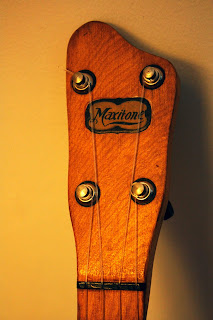The Gibson UB-2,3,4,5? What is it?
This is a response to several emails with questions about Gibson terminology.
Thanks to a few catalogs and possibly a few typos, we are left with a mountain of confusion about the Gibson line of banjo ukes. I've written more on this in my post about the various Gibsons but after seeing a few auctions recently I think it might help to propose something to the various sites and collectors out there.
We won't ever get any help from Gibson because they moved from Kalamazoo long ago and anyone working there that might help with this topic is probably long since retired. Also, they had a serious basement flood at their current factory and my guess is that any records on this topic might have been ruined .
First of all what I see is what might be a typo in the catalog that clearly lists the fancier inlay model (the one we all call the Ub-3) as a UB-2. Now, to my knowledge this was a bit of back labeling since the UB-2 and UB-3 had already been listed in their catalogs and were very established high production models. Also on that same page the catalog pictures a "UB-3" that looks to me like a UB-2 with an added diamond flanged resonator. This same page lists the UB-4 as gold plated ! That is three big changes in the terminology in one catalog. This must have been confusing to even the merchants and distributors at this point. For instance, you go to order a UB-3 and the resonator model shows up at your store? A nickel UB-4 shows up in gold? A UB-2 has fancy inlays and a sunburst finish?
I've tried to put myself in the shoes of the Gibson folks and have a theory about this catalog. By this point they had the UB-4, and of course, the ub-1,ub-2 and ub-3 as well. Now, we have this resonator that we want to include on the less ornate UB-2, and put a maple version of it on there and leave the fingerboard pear wood and leave the mother of pearl dots......oh, and leave out the tone ring that the UB-4/5 has. What are we going to call it? For some reason, calling it the UB-2 deluxe or something like that was not their choice and they chose to call it the UB-3. I also think they might have dropped the original ub-2 at that point. Also, I have to wonder, what would they have called the UB-3 with an added diamond resonator? I think it is obvious that they were boxed in by the UB designation that had a basic model at one end, and a fancy model at the other, leaving them three already used numbers to restructure the whole labeling process.
Since we have no serial numbers on most of the Gibson models, the best we can do is go by the fret boards. To me they hold the key to the terminology. Also, if we use the "Deluxe" term it vastly helps with this topic. Since catalogs contradict each other and there is no way to trace what the factory was actually producing in a given year with serial numbers or factory records.
I would like to propose that we name them all according to the fret boards, and use the deluxe as a further indicator when there is a diamond flanged resonator. This might help to end what I am going to call "Gibson Catalog Wars"
so here is my proposition that is based on current usage:
UB-1 6" head, flat resonator, dot markers
UB-2 dot markers, 8 inch head, flat resonator
Ub-2 Deluxe dots, 8" head, diamond flanged resonator
UB-3 Fancy diamond fret markers with rosettes, with or without sunburst ,8" head, flat resonator
UB-3 Deluxe Same as UB-3 above with diamond flanged resonator (walnut back, tone ring?)
UB-4 8" head, Diamond resonator, nickel plated hardware, Walnut burl back, rosewood fret
board, mother of pearl inlay "The Gibson" and fancy inlays.
UB-5 Same as above but with gold hardware
Also, for any custom models it would help if we called them nearest to what they might have been as listed above. ie. custom Ub-3 etc.
I know this is contrary to some of the catalogs, but it seems like what many banjo uke players are already calling these models anyhow.
I don't have every model in my collection, and would love it if anybody with the deluxe models would write me about the tone ring, number of frets, type of wood on the backs etc. to share with my readers. Pictures would be greatly appreciated too!

















































